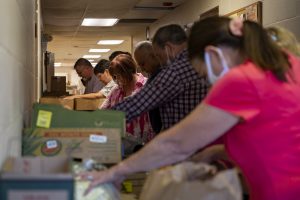News
Food Banks Busy Serving More Families In Need
By: David Forster
Posted on:
ATHENS, Ohio (WOUB) — Anita Hajivandi is getting used to seeing a lot of new faces at the food pantry she helps run out of a small church in Meigs County.
But the stories they sometimes share with her — there’s no getting used to those.
One man, who was clearly uncomfortable coming to a food bank for help and seemed on the verge of tears, told her he had eaten only cabbage for a month.
“And at first I thought he said this week,” Hajivandi recalled. “And he said, ‘No, all I’ve eaten for an entire month, all I’ve ever had is cabbage, and I’m so hungry.’ And it just stopped me in my tracks.”
Over the past several months, the River of Life church has been serving more Meigs County families than ever as the coronavirus continues to take a heavy economic toll in southeast Ohio.
Hajivandi runs the food pantry with her husband. She grew up in the county and lives about a mile from the church, which is in Rutland.
She said the first big wave hit in July when 777 families came for food. This was more than double the number from July of last year. Many of these families had never been to the pantry before.

During the first three months after the lockdowns began in late March, more than 2.9 million Ohioans were served by a pantry or food bank, said Lisa Hamler-Fugitt, executive director of the Ohio Association of Foodbanks.
This was an all-time record.
In a recent survey by the U.S. Census Bureau, 11.1 percent of adults in Ohio reported that their households sometimes or often did not have enough food to eat in the past seven days.
The need is also reflected in applications for SNAP benefits, more commonly known as food stamps. Hamler-Fugitt said that Ohio is seeing one of the biggest increases nationwide in SNAP applications.
Applications surged in Ohio during the first two months of the pandemic then dropped back to more normal levels after Congress approved a massive stimulus package that included $600 in additional monthly unemployment benefits.
SNAP applications picked up again in August after those supplementary benefits ended at the end of July.
A second stimulus bill stuck in Congress for months now would provide another round of supplementary benefits along with an increase in the monthly food stamps payments to help offset a sharp increase in food prices during the pandemic.
But the bill has gone nowhere as Democrats in the House and Republicans in the Senate remain at odds over the size of the package and the Trump administration has sent mixed signals regarding its position.
“We desperately need a new COVID federal relief package to be able to begin to really address these food hardships and hunger rates,” Hamler-Fugitt said. “We are seeing an increase that’s growing in both its depth and severity, and it’s going to endanger our children’s health in the long-term as well as their educational outcomes.”
Some of the families visiting food banks are experiencing what they hope will be a temporary setback brought on largely by the pandemic.
But Hamler-Fugitt fears that many temporary layoffs may become permanent as businesses close, downsize or turn more to automation.
“We need to come to grips sooner rather than later that many of these jobs, especially in the low-wage service sector economy, will not come back,” she said.
Hamler-Fugitt also worries about the many struggling families who have been able to stay in their homes only because of a federal moratorium on evictions. But many of these families won’t have the means to catch up on their rent payments when the moratorium expires at the end of December.
“This only postpones the inevitable,” she said of the moratorium. “The evictions will happen. … My greatest fear as I see the huge number of Americans and Ohioans who are falling further behind in their rent is what is going to happen in the dead of winter when the evictions begin and these families end up out on the street?”
The coronavirus has not only brought more traffic to the River of Life church’s food pantry. It’s forced the pantry to change the way it operates.

The pantry is open every Wednesday evening, and on a recent Wednesday Hajivandi, her nose and mouth covered in a mask, walked up to each car with her clipboard and collected some basic information about the families. Many of them were regulars from even before the pandemic, and she often chatted with them a bit.
She then slapped a yellow sticky note on the windshield of each car indicating how many boxes of food it should receive.
Volunteers raced to keep up with the steady stream of cars, packing boxes into trunks and back seats. The boxes were filled with fresh fruits and vegetables, frozen meat, pasta, rice, bagels, peanut butter, canned goods and snacks.
Hajivandi has been surprised by how many new families are showing up since the pandemic began. Many of the new visitors are seniors living on fixed incomes.
One woman told Hajivandi that because of her Social Security benefits she didn’t qualify for food stamps, but that it wasn’t enough to cover her expenses and the insulin she takes for her diabetes.
“She said, ‘Sometimes I choose, do I take my insulin shots or do I only take half of it and go to the grocery store and buy food,’” Hajivandi said.
Some of the seniors are raising their grandchildren or even their great grandchildren. One older woman showed up with nine children packed into her car.
“I thought she was babysitting,” Hajivandi said. “And then when she told me she had custody of nine little children, several in diapers … what would I do? How would I feed them?”
Speaking of diapers, that’s a luxury many food banks cannot afford to provide. And they cannot be purchased with food stamps, which can only be used for food. This means no toilet paper, soap, shampoo, toothpaste or household cleaning products either.
Hamler-Fugitt said there is no dedicated source of government aid to help families with these necessities. Food banks offer what they can, when they can, but it’s far short of the need.
Hajivandi said she also hears from many people who had good jobs but lost them and for whatever reason have been unable to collect benefits. Or their benefits have run out or simply fall far short of the bills they have to pay.
“I don’t qualify for anything, and I have nothing. I’ve played by all the rules but I can’t get any help,” Hajivandi said they tell her. “And that’s hard to see. But we welcome everyone. We welcome everyone. It’s just, you wish it was different.”

